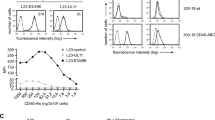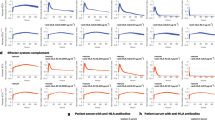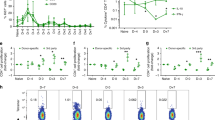Abstract
Xenogeneic tissues induce vigorous T cell immunity, reflecting the ability of costimulatory molecules to function across species barriers. We describe a strategy to inhibit costimulation that exploits species differences using the model of porcine pancreatic islet transplantation into mice. Mice were immunized with chimeric peptides that contained a known T cell epitope and selected sequences of the porcine costimulatory molecule CD86. This resulted in anti-peptide antibody responses that recognized intact porcine CD86, blocked costimulation by porcine CD86 but not murine CD86 in vitro, and prolonged the survival of porcine islet grafts in vivo. This strategy of inducing endogenous donor-specific costimulatory blockade has potential clinical applicability.
This is a preview of subscription content, access via your institution
Access options
Subscribe to this journal
Receive 12 print issues and online access
$209.00 per year
only $17.42 per issue
Buy this article
- Purchase on Springer Link
- Instant access to full article PDF
Prices may be subject to local taxes which are calculated during checkout






Similar content being viewed by others
References
Waterworth, P.D. et al. Life-supporting pig-to-baboon heart xenotransplantation. J. Heart Lung Transpl. 17, 1201–1207 (1998).
Zaidi, A. et al. Life-supporting pig-to-primate renal xenotransplantation using genetically modified donors. Transplantation 65, 1584–1590 (1998).
Schmoeckel, M. et al. Orthotopic heart transplantation in a transgenic pig-to-primate model. Transplantation 65, 1570– 1577 (1998).
Dorling, A. & Lechler, R. I. in The passenger leucocyte, dendritic call and antigen-presenting cells (APC) (eds Tilney, N. L., Strom, T.B. & Paul, L.C.) (Lippincott-Raven, Philadelphia, 1996).
Dorling, A., Lombardi, G., Binns, R. & Lechler, R. I. Detection of primary direct and indirect human anti-porcine T cell responses using a porcine dendritic cell population. Eur. J. Immunol. 26, 1378–1387 (1996).
Dorling, A., Binns, R. & Lechler, R.I. Cellular Xenoresponses: Observation of significant primary indirect human T cell anti-pig xenoresponses using co-stimulator-deficient or SLA class II-negative porcine stimulators. Xenotransplantation 3, 112–119 ( 1996).
Kumagai-Braesch, M., Johansson Borg, A., Satake, M. & Moller, E. Characteristics of direct and indirect activation of human T cells against allogeneic and porcine xenogeneic cells/peptides. Xenotransplantation 4, 85–94 (1997 ).
Kirk, A.D., Hall, B.L., Finn, O.J. & Bollinger, R.R. In vitro analysis of the human antiporcine T-cell repertoire. Transpl. Proc. 24, 602–603 ( 1992).
Yamada, K., Sach, D.H. & DerSimonian, H. Human anti-porcine xenogeneic T cell response. Evidence for allelic specificity of mixed leukocyte reaction and for both direct and indirect pathways of recognition. J. Immunol. 155, 5249–5256 (1995).
Satake, M., Kawagishii, N. & Moller, E. Direct activation of human responder T cells by porcine stimulator cells leads to T cell proliferation and cytotoxic T cell development . Xenotransplantation 3, 198– 206 (1996).
Kirk, A.D. et al. The human antiporcine cellular repertoire. In vitro studies of acquired and innate cellular responsiveness. Transplantation 55, 924–931 ( 1993).
Maher, S.E. et al. Porcine endothelial CD86 is a major costimulator of xenogeneic human T cells: cloning, sequencing, and functional expression in human endothelial cells. J. Immunol. 157, 3838– 3844 (1996).
Lenschow, D.J. et al. Inhibition of transplant rejection following treatment with anti-B7-2 and anti-B7-1 antibodies. Transplantation 60, 1171–1178 (1995).
Sun, H. et al. Prevention of chronic rejection in mouse aortic allografts by combined treatment with CTLA4-Ig and anti-CD40 ligand monoclonal antibody. Transplantation 64, 1838–1843 (1997).
Larsen, C.P. et al. Long-term acceptance of skin and cardiac allografts after blocking CD40 and CD28 pathways. Nature 381, 434–438 (1996).
Baliga, P. et al. CTLA4Ig prolongs allograft survival while suppressing cell-mediated immunity. Transplantation 58, 1082– 1090 (1994).
Turka, L.A. et al. T-cell activation by the CD28 ligand B7 is required for cardiac allograft rejection in vivo. Proc. Natl Acad. Sci. USA 89, 11102–11105 (1992).
Lin, H. et al. Long-term acceptance of major histocompatibility complex mismatched cardiac allografts induced by CTLA4Ig plus donor-specific transfusion. J. Exp. Med. 178, 1801–1806 (1993).
Lenschow, D.J. et al. Long-term survival of xenogeneic pancreatic islet grafts induced by CTLA4lg. Science 257, 789– 792 (1992).
Lu, L. et al. Blockade of the CD40-CD40 ligand pathway potentiates the capacity of donor-derived dendritic cell progenitors to induce long-term cardiac allograft survival. Transplantation 64, 1808– 1815 (1997).
Hornick, P.I. et al. Assessment of the contribution that direct allorecognition makes to the progression of chronic cardiac transplant rejection in humans . Circulation 97, 1257– 1263 (1998).
Mason, P.D., Robinson, C.M. & Lechler, R.I. Detection of donor-specific hyporesponsiveness following late failure of human renal allografts. Kidney Int. 50, 1019–1025 (1996).
Mirenda, V. et al. Intact pancreatic islet function despite humoral xenorecognition in the pig to monkey combination. Transplantation 66 , 1485–1495 (1998).
Simeonovic, C.J., Bowen, K.M., Kotlarski, I. & Lafferty, K.J. Modulation of tissue immunogenicity by organ culture. Transplantation 30, 175–179 ( 1980).
Faustman, D.L. et al. Prevention of rejection of murine islet allografts by pre-treatment with anti-dendritic cell antibody. Proc. Natl Acad. Sci. USA 81, 3864–3868 (1984).
Sad, S., Talwar, G.P. & Raghupathy, R. Influence of the genetic background and carrier protein on the antibody response to GnRH. J. Rep. Immunol. 19, 197 (1991).
Graham, F.L. & Van der Eb, A.J. A new technique for the assay of infectivity of human adenovirus 5 DNA. Virology 52, 456 (1973).
Galvin, F. et al. Murine B7 antigen provides a sufficient costimulatory signal for antigen-specific and MHC-restricted T cell activation. J. Immunol. 149, 3802–3808 ( 1992).
Ball, J.M., Henry, N.L., Montelaro, R.C. and Newman, M.J. A versatile synthetic peptide-based ELISA for identifying antibody epitopes . J. Immunol. Meth. 171, 37– 44 (1994).
Ricordi, C., Socci, C. & Davalli, A.M. Isolation of elusive pig islets. Surgery 107, 688–694 ( 1990).
Acknowledgements
We thank G. Taylor for assistance in the selection and design of the chimeric peptides, A.Chaudry for help with statistical analysis, H. Reiser for the donation of CHO transfectants, and H. Stauss and A. George for reading the manuscript. Supported by ML laboratories, St. Albans, Hertfordshire; additional funding was provided by PPL Laboratories, Scotland.
Author information
Authors and Affiliations
Corresponding author
Rights and permissions
About this article
Cite this article
Rogers, N., Mirenda, V., Jackson, I. et al. Costimulatory blockade by the induction of an endogenous xenospecific antibody response. Nat Immunol 1, 163–168 (2000). https://doi.org/10.1038/77853
Received:
Accepted:
Issue Date:
DOI: https://doi.org/10.1038/77853



